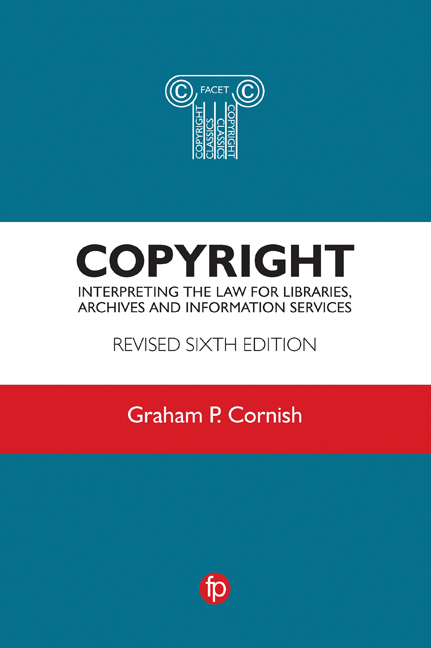Book contents
- Frontmatter
- Contents
- Author's note
- Acknowledgements
- List of abbreviations
- Introduction
- Section 1 Definition and law
- Section 2 What is covered by copyright?
- Section 3 Rights and limitations
- Section 4 Literary, dramatic and musical works
- Section 5 Artistic works
- Section 6 Sound recordings and performers’ rights
- Section 7 Films and videos
- Section 8 Broadcasts
- Section 9 Databases
- Section 10 Licensing schemes and licences
- Section 11 Computer programs, the electronic world and websites
- Section 12 Other matters
- Useful Addresses and Contacts
- Useful Sources of Information
- Appendix: suggested declaration forms
- Index
Section 5 - Artistic works
Published online by Cambridge University Press: 19 November 2019
- Frontmatter
- Contents
- Author's note
- Acknowledgements
- List of abbreviations
- Introduction
- Section 1 Definition and law
- Section 2 What is covered by copyright?
- Section 3 Rights and limitations
- Section 4 Literary, dramatic and musical works
- Section 5 Artistic works
- Section 6 Sound recordings and performers’ rights
- Section 7 Films and videos
- Section 8 Broadcasts
- Section 9 Databases
- Section 10 Licensing schemes and licences
- Section 11 Computer programs, the electronic world and websites
- Section 12 Other matters
- Useful Addresses and Contacts
- Useful Sources of Information
- Appendix: suggested declaration forms
- Index
Summary
Definition
What is the definition of an artistic work?
The definition of artistic works is given in the CDPA as:
• graphic works such as paintings, drawings, diagrams, maps, charts and plans, engravings, lithographs, etchings or woodcuts, sculpture, collage; this includes the surface design of manufactured products such as pottery and textiles
• photographs (including slides and negatives as well as microforms)
• architectural works (including buildings of any kind)
• works of artistic craftsmanship, such as jewellery or pottery.
Does the work have to have some artistic quality to be protected by copyright?
No, but see the notes below on works of artistic craftsmanship where the situation is somewhat different. Otherwise quality is not a requirement but the usual tests of originality and showing some skill and creativity apply.
What is the definition of a photograph?
A photograph is defined as: ‘photograph means a recording of light or other radiation on any medium on which an image is produced or from which an image may by any means be produced, and which is not part of a film’.
Do microforms qualify for copyright?
Certainly. A microfilm or microfiche (‘microforms’ for short) is a photograph and attracts copyright in the same way as a photograph itself. A microfilm containing several different documents may also be a database (see Section 9).
What happens if the work which has been microfilmed is still in copyright?
There are then two copyrights, one in the original document and one in the microform. To make the new copy would require the consent of the original copyright owner.
Supposing the work that has been microfilmed is out of copyright?
There is probably still copyright in the microform as a photograph even though the work photographed is out of copyright. Some authorities argue that there is no copyright in the photograph of a ‘flat’ object such as a document but others would argue that change of medium (from paper to photograph) requires sufficient skill to create a new original work. But a straightforward photocopy or scanned copy of the work would not attract a new copyright as there would be insufficient skill shown in making the copy to justify a new copyright.
- Type
- Chapter
- Information
- CopyrightInterpreting the law for libraries, archives and information services, pp. 85 - 104Publisher: FacetPrint publication year: 2019



